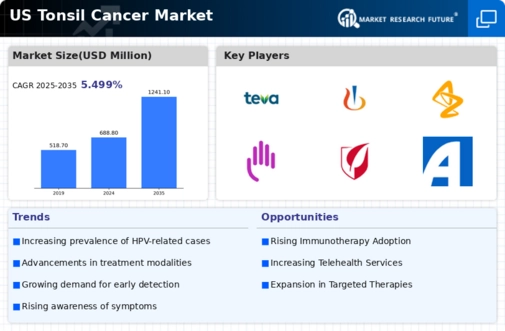Growing Incidence of Tonsil Cancer
The rising incidence of tonsil cancer in the US is a critical driver for the tonsil cancer market. Recent statistics indicate that the number of new cases has been increasing, particularly among younger populations. This trend is likely attributed to the rising prevalence of human papillomavirus (HPV) infections, which are known to be a significant risk factor for tonsil cancer. As awareness of this disease grows, healthcare providers are more vigilant in screening and diagnosing tonsil cancer, leading to earlier detection and treatment. Consequently, this surge in cases is expected to drive demand for innovative therapies and treatment options within the tonsil cancer market, potentially increasing market revenue significantly over the coming years.
Rising Investment in Oncology Research
Rising investment in oncology research is a driving force behind advancements in the tonsil cancer market. Increased funding from both public and private sectors is facilitating the exploration of novel therapies and treatment strategies. Research institutions and pharmaceutical companies are focusing on understanding the molecular mechanisms of tonsil cancer, which may lead to the development of more effective treatment options. This influx of investment is likely to accelerate clinical trials and the introduction of new drugs into the market. As a result, the tonsil cancer market could experience substantial growth, with estimates suggesting an increase in market size by over 15% in the next five years.
Regulatory Support for Innovative Therapies
Regulatory support for innovative therapies is emerging as a significant driver in the tonsil cancer market. The US Food and Drug Administration (FDA) has been actively streamlining the approval process for new cancer treatments, particularly those that demonstrate promising results in clinical trials. This supportive regulatory environment encourages pharmaceutical companies to invest in the development of novel therapies for tonsil cancer. As a result, the introduction of breakthrough treatments is likely to enhance patient access to effective care options. This trend may lead to a more competitive landscape in the tonsil cancer market, fostering innovation and potentially increasing market revenues by a notable margin.
Increased Awareness and Education Initiatives
Increased awareness and education initiatives regarding tonsil cancer are pivotal in shaping the tonsil cancer market. Public health campaigns aimed at educating the population about the symptoms, risk factors, and the importance of early detection are gaining momentum. These initiatives are likely to lead to higher screening rates and earlier diagnoses, which can significantly impact treatment outcomes. As more individuals become informed about tonsil cancer, the demand for diagnostic services and treatment options is expected to rise. This heightened awareness could potentially result in a market growth rate of approximately 6% annually, reflecting the growing need for effective interventions in the tonsil cancer market.
Technological Innovations in Treatment Modalities
Technological advancements in treatment modalities are transforming the tonsil cancer market. Innovations such as robotic-assisted surgeries and targeted therapies are enhancing treatment efficacy and patient outcomes. For instance, minimally invasive surgical techniques are gaining traction, allowing for quicker recovery times and reduced hospital stays. Furthermore, the development of immunotherapies and personalized medicine approaches is likely to provide tailored treatment options for patients, improving survival rates. As these technologies become more widely adopted, they are expected to contribute to the growth of the tonsil cancer market, with projections indicating a potential market value increase of over $1 billion by 2030.






















Leave a Comment